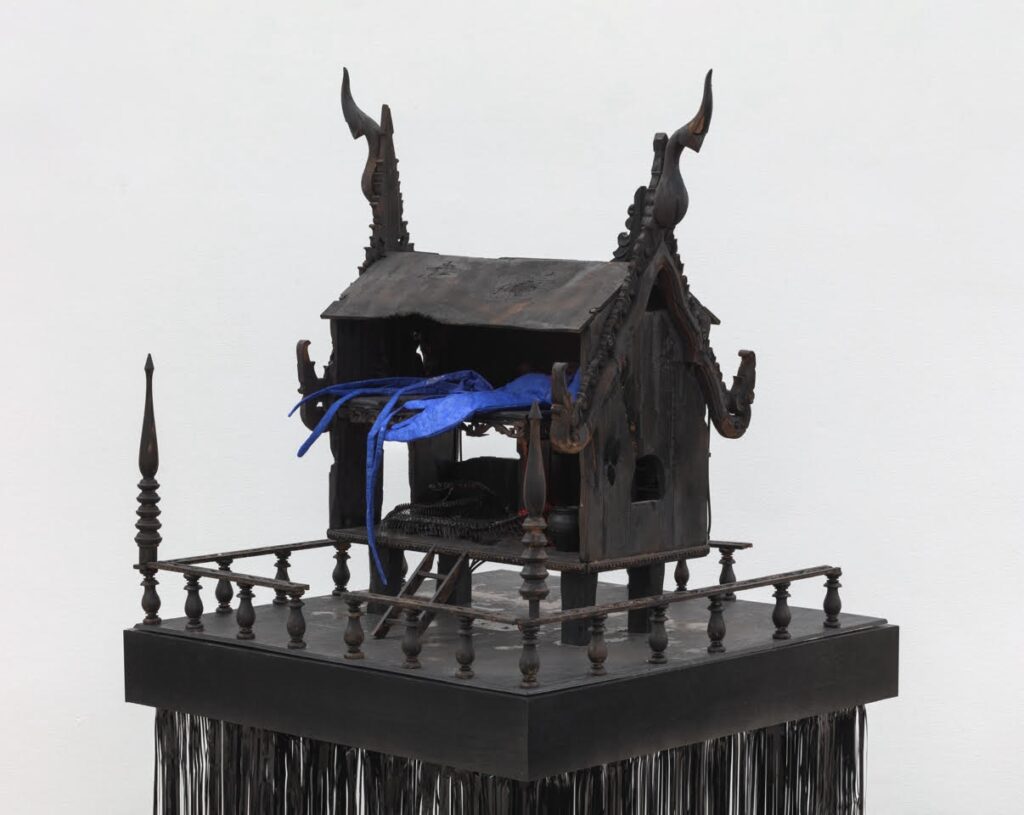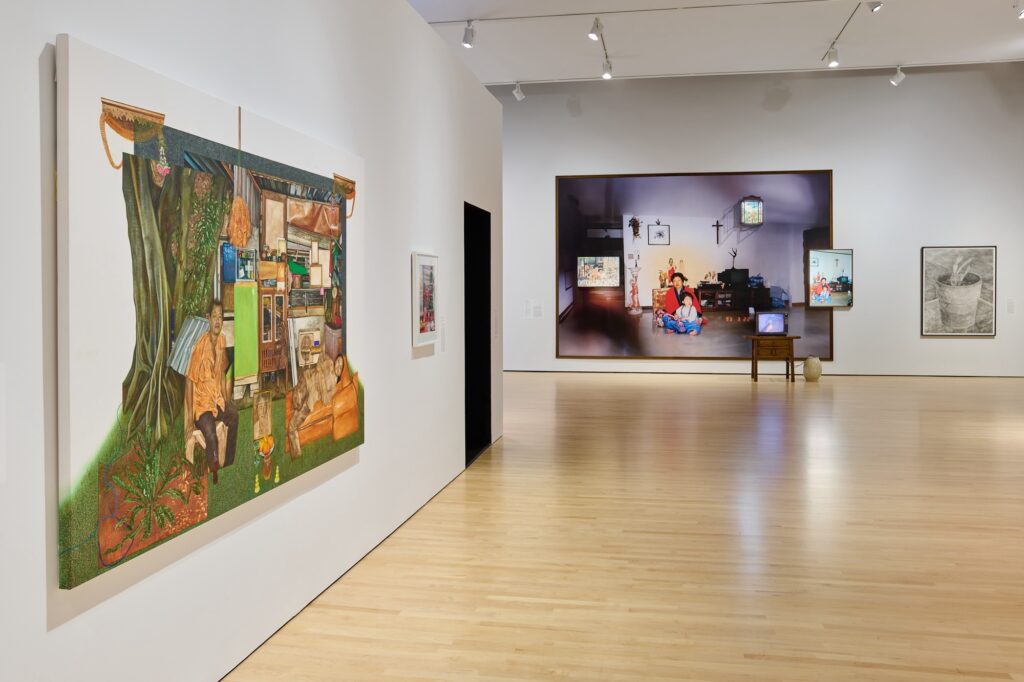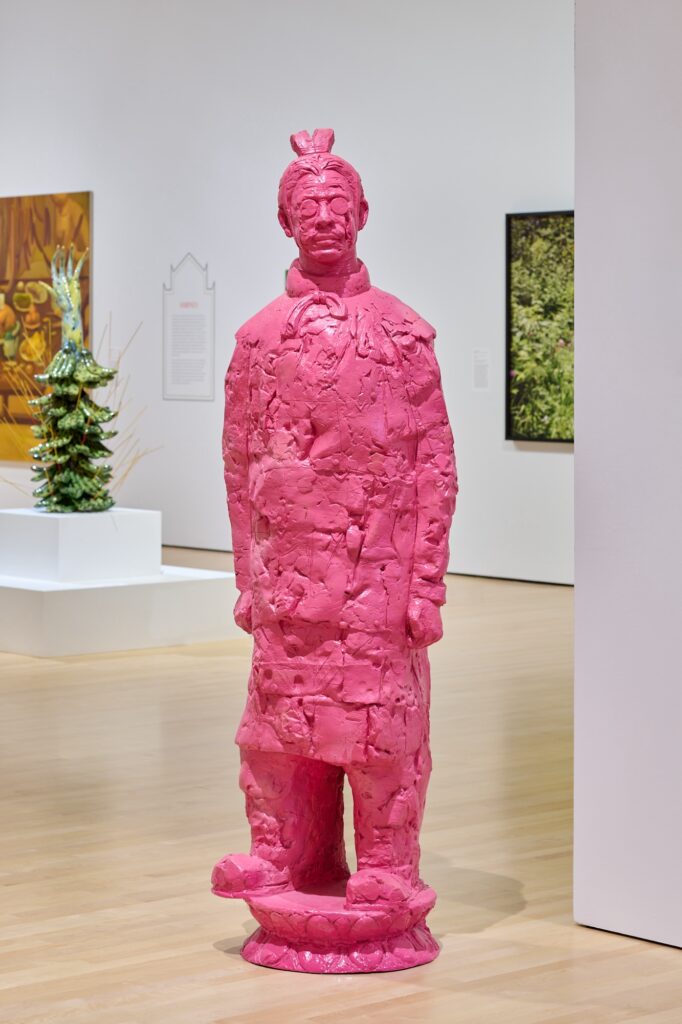In the introduction to the catalogue for Spirit House, an exhibition at Stanford’s Cantor Arts Center through Sun/26, curator Aleesa Pitchamarn Alexander writes about how she, like her mother and grandmother, had sleep paralysis, which sometimes led to seeing dark figures and hear disembodied voices. Rather than being perceived as a kind of trauma, in Thailand, where she was born and grew up, it was believed to be caused by a spirit. Alexander writes she saw these events as “sneak peeks into the beyond.”
In a lot of Southeast Asia, there are almost daily opportunity to consider life and death and the border between them, Alexander says. One way is through spirit houses, small structures with offerings outside of most buildings in Thailand.
Alexander grew up in Bangkok where spirit houses were everywhere. She was thinking about them—as well as haunting, talking to ghosts, shrines, and migration when she organized this show, which explores the idea of artists traveling through time and space.
The 33 artists of Spirit House who work in mediums including sculpture, painting, photography and digital media, include six from the Bay Area: Binh Danh, Heesoo Kwon, Reagan Louie, Cathy Lu, Namita Paul, and Wanxin Zhang.
Alexander spoke with us about the show, the thinking behind it, and its touchingly broad appeal.
48 HILLS It seems like so much work went into this. How long had you been thinking about the exhibition?
ALEESA PITCHAMARN ALEXANDER I have been working on the show for two years. But if I think about my life, I feel like I’ve been thinking about some of these ideas forever. The show is not just about art history—to me, it’s about broader existential questions in life, and this desire to transcend the limits of linear time, and to talk to those who have passed on, or to go back to a homeland that you can’t live in. These are all things that I’ve been thinking about for quite a long time, so it’s all kind of informed by that. Then once I started meeting artists who I felt like were interested in the same things, it really crystallized into this idea. Not every project is like this, where it feels very personal.

48H You say you were meeting artists who were thinking about the same kinds of things as you. What were they thinking about?
APA I think it was family history a lot. That means negotiating between worlds, because some people are first generation, or some people are second generation, and their folks were born in another place. Also, if you think about family history, then you are also thinking about ancestry. A lot of artists in the show are making work in collaboration with family members, or thinking about family relationships, like Kelly Akashi’s work and Greg Ito’s work. Korakrit’s [Arunanondchai] spirit house [Shore of Security] was made in collaboration with his mom and Lien Truong’s portrait is of her grandmother, and Tommy Kha’s portrait is of his grandmother, and Jarod Lew’s photo is of his mom, so it’s thinking about the dimensions of family.
48H How did you start thinking about the show? Were there certain artists you wanted? Or do you think of the sections first?
APA I had been doing studio visits with folks for longer than two years, so even the virtual studio visits that I was doing in 2020 helped inform a lot of this. And you saw my last big project, East of the Pacific. I knew after that I really wanted to work with living artists, thinking about the lessons from that show, and thinking about how so many artists, historical artists, had difficulty finding meaningful platforms to support their work. So I was thinking about what I could do with living artists.
I spoke with Veronica [Roberts, the director of the Cantor] about it, and she also agreed that we should do a contemporary show. I had acquired the Dominique Fung painting [The Largest and Most Formal Meal of the Day] that’s in the show in 2021. We had showed Do Ho Suh’s work at the Cantor in the past. So it was just like slowly accumulating these different ideas and works. And once you have a contemporary show on the calendar, what is the theme? I started considering my own life and a way to create a framework that wasn’t just about identity. I felt like so many shows about BIPOC artists, the central framing is about race and identity. Obviously that matters a lot here, but to me that’s not the primary thesis of the show.
The introductory essay in the catalog is about thinking about spirit houses and what they represent, and my initial fascination with them and as a child, and how that oriented me within the world. I felt like a lot of these artists had a kind of similar orientation towards the world that is markedly different than the Eurocentric or Western perspective. Then I started doing more of studio visits with artists, having this idea in the back of my mind. I had known about, Heesoo’s [Kwon], work for a long time. I had met Wanxin [Zhang] in 2021 and I had met Reagan Louie in early 2021, so it all just kind of started coming together. Once I had the framework for the Spirit House, I started really looking at the work.

48H Bay Area artists are such an integral part of the show…
APA I think it’s really important to support your community as much as possible. So, if I was going to work with living artists and not have a significant representation of those in my community, that doesn’t feel responsible or really accurate. A lot of those artists helped really inspire the show. I wanted a range of representation in terms of ages, points in their career, media, and geographical or ancestral diversity. I’ve known about Binh [Danh]’s work since I started at the Cantor. When you look at his work that’s in the show, it’s clearly a major inspiration.
Namita [Paul] came about because she I saw her MFA thesis at the Wattis. Even though she wasn’t an artist I was very familiar with, I felt that particular work was so strong. And then with Heesoo, especially because she’s local, I was really excited to work together with her to make something very particular for Spirit House. We’d been having such great conversations over the last few years, and I really wanted to be able to support her in pushing her practice in a new direction.
48H I read a quote from you: You were talking about artists traveling through time and place. Do you feel like that happens with most art, or mostly with the artists you chose for this show?
APA I think all art to some degree does that. That’s why I became an art historian, because it allows you access to these different places and time periods. But I feel like, in a very specific way, the artists in Spirit House were doing it rather intentionally. I can feel like I’m back in the Renaissance by reading about and looking at its art. But this is different. Speaking with Heesoo, we were thinking about ways to use art to think differently about time, about life, about the afterlife. A lot of the artists in the show talk about reincarnation. So I think it means something rather specific here, even though I think that all really great art has that capacity.
48H Why is it so important to tell personal histories through art or through in any way?
APA There’s so many ways to answer that. Talking to artists of an older generation, like Reagan Louie for example, he’s shared with me how when he was in Yale, talking about one’s identity or biography was basically considered non-serious art-making, that it was more of a formalist enterprise. I don’t see my generation or younger generations feeling that same way. We very much feel that because of that exclusion, our experiences and histories are worthy subjects of art. If we don’t chronicle them or document them, history has shown that it will not take into account the worlds that we experience. It’s taking matters into your own hands, and I think that’s what these artists are doing.
For so many of us, our entry point to something as historical as, say, Japanese American incarceration in 1942, is through an individual, or through a story. We’re very compelled by narratives and stories. It’s why we read books and why people tell stories in the first person. That’s how we can enter a narrative. I think it’s a very powerful tactic. We have stories that we want to tell, and we know nobody else can tell them. It’s such an important generational shift in terms of biography.

48H What has been one of the most satisfying things about doing this show for you?
APA Working with all these artists and forming meaningful relationships with them has been so life-changing. I always think that artists are the most interesting interlocutors. I will treasure and value that forever, and I hope this isn’t the last time that I get to work with many of them. We’ve been getting such interesting audience responses, some of which I gather through Christine Wong Yap’s decompression space, which is so beautiful.
Many people have told me—and they’re primarily Asian American, but not exclusively—that they have seen the show multiple times, and have returned with their family. Many have written the most profoundly moving responses about how their family never cared about art, they never got it, but going to the show, you could see that it was different for them, that there was this kind of transformation in their eyes about what art could do and what it could be.
I heard this funny phrase over and over again—I mean, funny, very sweet phrase—that the show felt like walking into their family home, or like their grandparents’ living room. It felt really familiar, spiritually familiar and close to them. I will always remember that. Getting that kind of community response, and seeing that it actually is really moving to people, or having Stanford students say that it changed their life to be able to see a show like this, or older folks to say, ‘I couldn’t even imagine something like this happening 10 years ago, but to see it happen now is so awesome.’ If it moves people and they feel like they’ve had a profound experience, I can’t be mad at that.
SPIRIT HOUSE runs through Sun/26 at Stanford’s Cantor Arts Center, Palo Alto. More info here.





